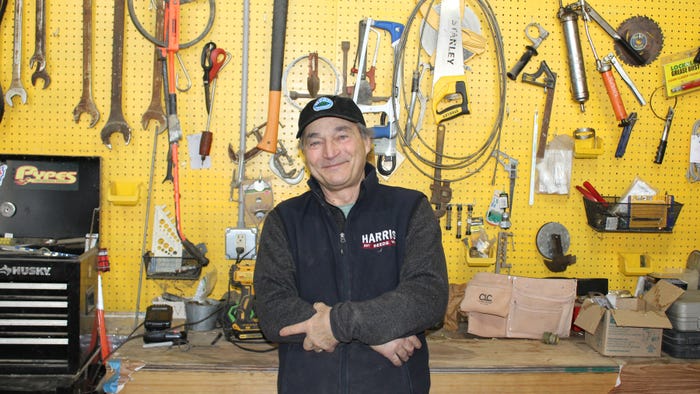March 23, 2023

Photos by Susan Harlow
Reduce, reuse, repurpose. Howard Prussack took that slogan to heart in designing his farm workshop a dozen years ago.
Only the hand-hewn posts and rafters from the early 1800s tell you that the new shop once housed dairy cows.
“I’m sort of anti-sprawl and didn’t want to build a new building. I wanted to utilize the space I have, so I could really use it instead of having it just full of crap,” says Prussack, an organic vegetable producer in Westminster, Vt.
Prussack’s High Meadows Farm, the first farm in Vermont to be certified organic, sells wholesale vegetables and bedding plants to co-ops in Vermont, New Hampshire and Massachusetts. He’s a longtime vendor at the Brattleboro Farmers Market.
Prussack transformed the 80-by-40-foot bottom floor of his former dairy barn into a workshop space that also functions as a storage and wash area for his vegetables. Once dark and chilly, the area is now well-lighted, warm and easily accessible with a pallet jack.
The how-to
Prussack began by removing the old stanchions (he kept the wooden ones: “antiques,” he says). Then came the hardest part: Jackhammering out old concrete feed troughs and pouring a new floor, with drains. Insulation board went up on the ceiling and along the east wall. The west wall of the sidehill barn is protected below grade.
A ceiling-mounted propane heater works only in very cold weather.
Prussack organizes his tools and equipment in the north end of the space, with pegboards, an industrial tool storage cabinet, and containers for screws, nails and other small stuff. He keeps grease and oil on hand.
“The small mechanical stuff, I can take care of. I don’t do welding, but there are several people around who do. For big engine stuff, too, I can usually find someone to do the work. There are some real wrench heads around here,” he laughs.
The other end of the barn, which once housed heifers, is now an area to wash vegetables, with stainless steel sinks, a wash table and cookers for Prussack’s famous black garlic.
After working a few years in what felt like a dark, cold shed — the old dairy-barn environment — Prussack had another brainstorm. “I said, ‘Why don’t we take off the metal roof and get the sun in here?’”
He replaced the roof and sidewall of the heifer area with double-walled polycarbonate to let in the light. In summer, he sprays it with liquid shade, which filters sunlight but wears off by the time winter arrives.
So, what would Prussack do differently if he were renovating his shop again? He says that he would make sure the concrete floor was smooth and polished to cut down on noise and make it easier to clean.
Prussack also converted a nearby unused greenhouse into a garage for winter equipment storage and work area. There, he can change the oil and do other routine offseason maintenance on his tractors and other equipment.
“I would never build a barn again,” he says. “A greenhouse is warm, dry and light, and not expensive to build.”
Planning a shop
Adequate space should be one of the first considerations in planning a workshop, says Chris Callahan, agricultural engineer with University of Vermont Extension.
“Most farmers probably wish they had more room,” he says. “There’s always more projects than space and time, and projects often reach a point of waiting for parts or other delays that require them to be left in place midway.”
Sufficient light is also important, he says, especially as we age. Employing natural light well, as Prussack does, should be the first objective when planning for light. And for many shop renovations, a good heating system is near the top of the list.
“So many farmers I know just love the idea of a radiant slab of concrete to work on, even if it’s just to stand on, not to mention crawling under a vehicle on your back,” he says.
Callahan often sees differences between the shops of younger farmers and those of older farmers.
“The former [younger farmers] are often about getting the job done, no matter what odd lifting motion or body position is required,” he says. “The latter are like a pair of comfortable jeans or broken-in boots. You can see where the use and wear of time, and accrued wisdom, have led to ease of movement and resting places that match the natural flow of the body and work. I enjoy spending time in workshops with older folks who have a patient, intentional movement, and are set up for the work, both in thought and in action.”
Find out more from Callahan on how to build a workshop and other farm buildings at go.uvm.edu/barnplans and go.uvm.edu/ageng.
Harlow writes from New Hampshire.
Read more about:
BuildingsAbout the Author(s)
You May Also Like




